Top 11 Interesting Facts about Frida Kahlo
The fact that one of their own succeeded and achieved fame makes Frida Kahlo a symbol of feminism, women's empowerment, pride for the LGBTQIA community, Latinx ... read more...community, artists, and distinctive personalities. If you identify as Latinx, there's a high chance you're a huge Frida Kahlo admirer and are familiar with a lot of her creative output. But how much do you know about her? We wanted to learn more, so we did some research and found a few interesting facts about Frida Kahlo that everyone should be aware of.
-
One of the interesting facts about Frida Kahlo is Frida wasn’t Kahlo’s first name and her birthday wasn't the exact date. Frida Kahlo is a well-known figure. But what if we told you that Kahlo didn't actually go by the moniker Frida or even had a first name at all? You must be in awe! Magdalena Carmen Frieda Kahlo y Calderon was Frida Kahlo's real name. The German term Friede/Frieden, which means "peace," is where the name Frieda originated. According to some reports, she switched to the Latinized spelling of Frida, while others claim that she was born Frida and changed her name to the Germanized version in honor of her father, Guillermo (born Carl Wilhelm Kahlo, in Germany).
Wow, Frida was a true rebel. She maintains that she was born on July 7, 1910, even though her birth certificate lists her date of birth as July 6, 1907. This decision wasn't made at random. The 10-year-long Mexican revolution began in the year 1910. Frida Kahlo, who had a strong sense of patriotism, constantly aimed to speak up for the underprivileged. She did not merely dispute her birth date to seem younger; her motivation to do so was politically motivated. Kahlo rose to prominence as a symbol of Mexican culture, particularly indigenous culture.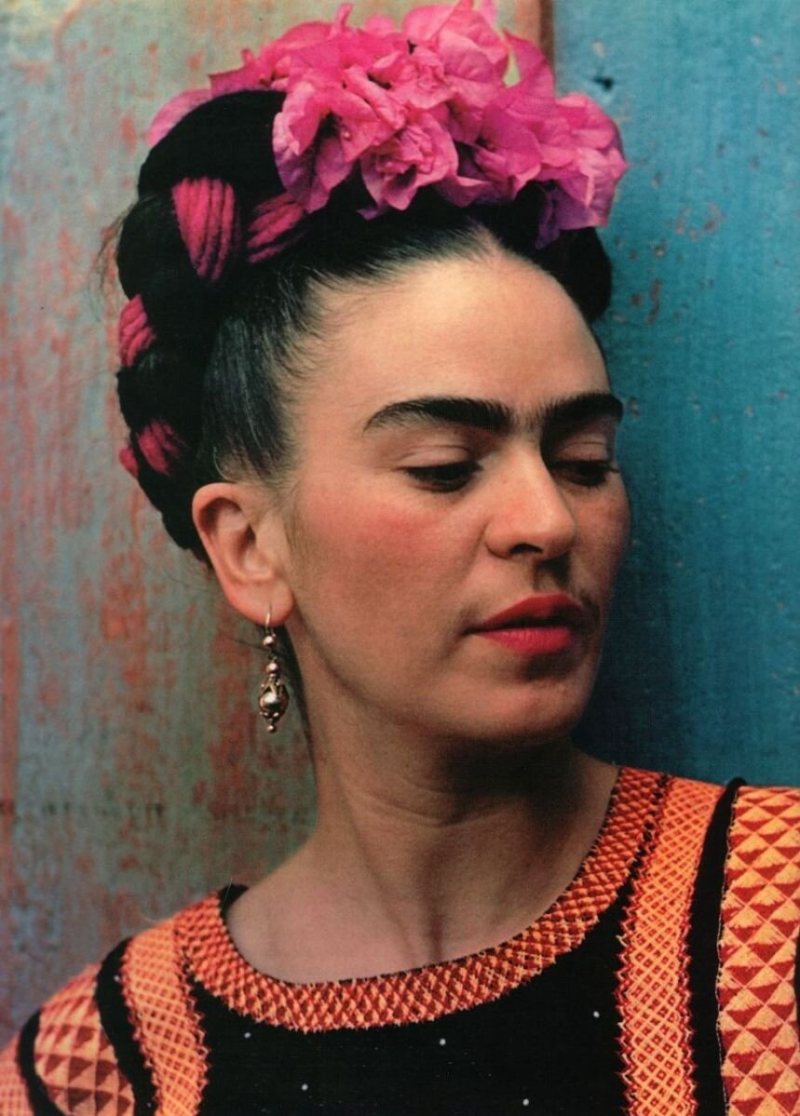
www.biography.com 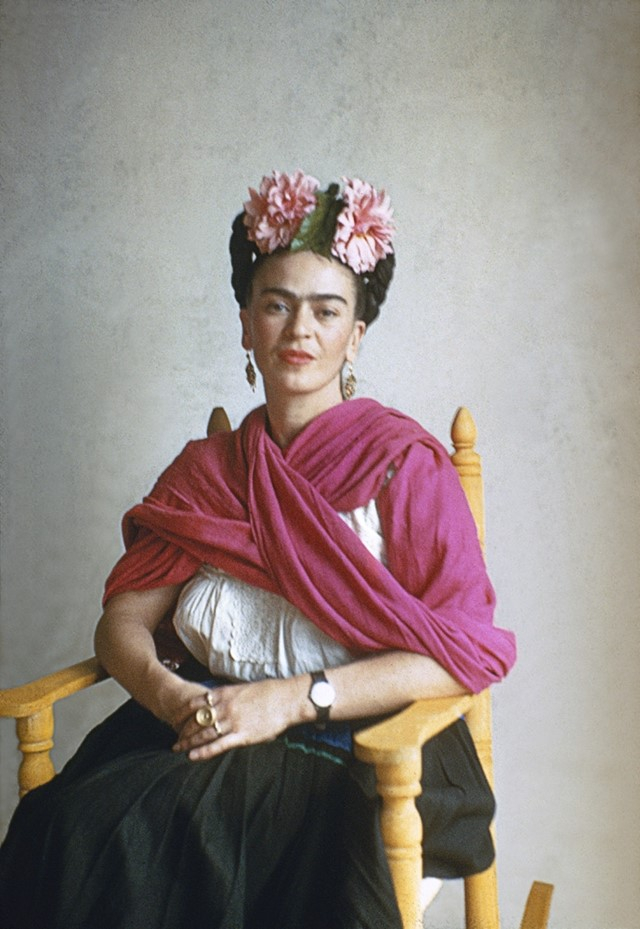
www.biography.com -
The mother of Frida Kahlo was mestiza—both Native American and comes from a line of generals in Spain. Frida was incredibly proud of her American Indian and Mexican heritage, and her work and appearance both reflected this. She portrayed herself in her paintings wearing traditional Tehuana attire and braiding ribbons in her hair. Additionally, Mexicanidad has had a significant impact on both her work and way of life.
Did you know that Frida Kahlo's father was not at all Latinx despite her strong ties to Mexican, Indigenous, and Latinx culture? Her parents, photographer Guillermo Kahlo (1871–1941) and her mom (1876–1932) were, respectively, 36 and 30 years old at the time of her birth. Carl Wilhelm Kahlo was born in Germany as Guillermo Kahlo and left his own country in 1891 to pursue his university education in Mexico due to epilepsy brought on by an accident. Although Kahlo claimed that her father was Jewish and that her paternal grandparents were Jews from the city of Arad, this claim was denied in 2006 by two German genealogists who discovered that he was really from a Lutheran family in the Grand Duchy of Baden. He used the name Guillermo Kahlo and established herself as a photographer when he landed in Mexico in 1891. Along with Kahlo, her parents gave birth to the daughters Matilde (1898–1951), Adriana (1902–68), and Cristina (1898–1964). Besides, she has two half-sisters, Maria Luisa and Margarita, from Guillermo's first marriage.
Later, Kahlo recalled that her childhood home was frequently "very, very melancholy." Both parents suffered from frequent illnesses, and their marriage lacked affection. She had a very strained relationship with her mother, Matilde. According to Kahlo's description of her mother, she was "kind, busy, and brilliant, but also cunning, harsh, and fanatically devout."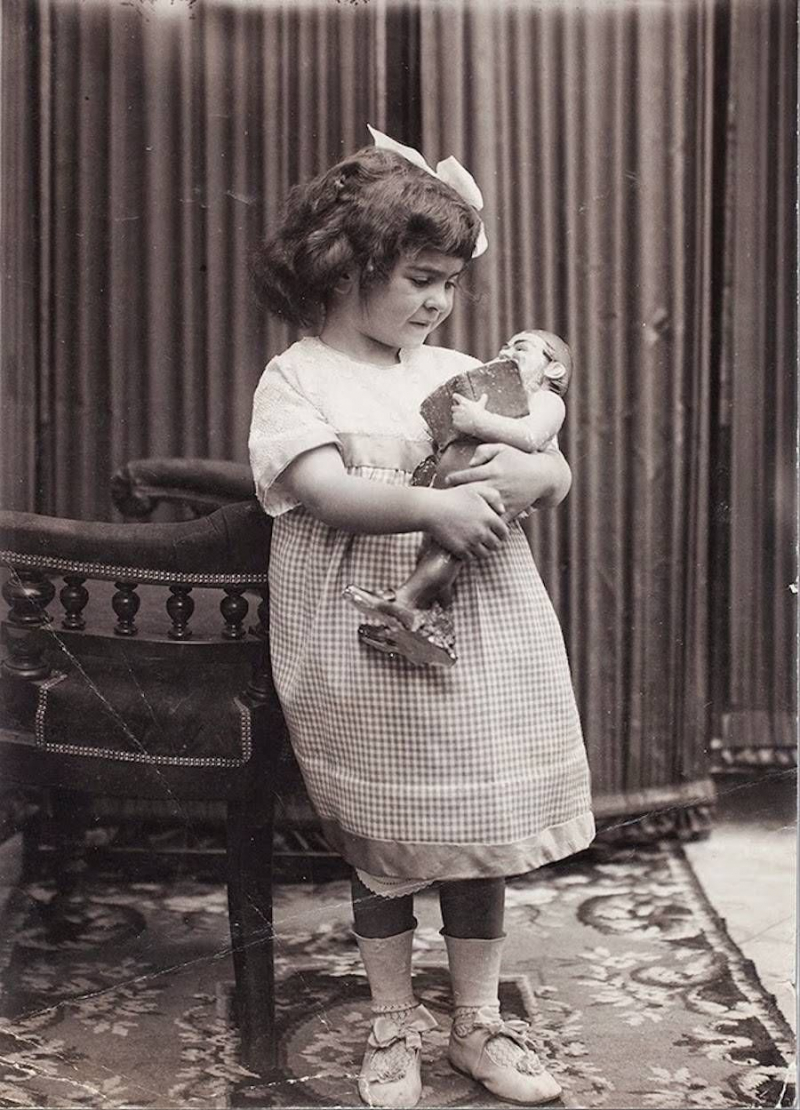
Frida at age 2 in 1909 -- www.aruma.com.au 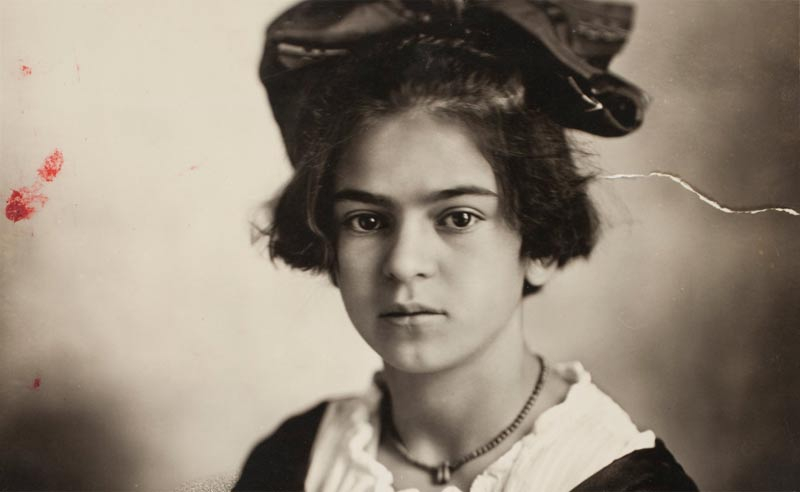
Frida at age 12 in 1919 -- www.aruma.com.au -
After her mother lost a son, Frida Kahlo was born. Her mother entrusted her to a nanny out of depression. She was an icy individual. In particular, the mood at home is depressing. Her father's company was struggling during the Mexican revolution, aside from conflicts in the family and two missing half-sisters since they were sent to the convent.
Moreover, in her early years, Frida Kahlo was not in good health. When she was 6 years old, she was diagnosed with polio and had nine months of bed rest. Her right foot and leg became thinner than her left due to this illness. After overcoming her polio, she walked with a limp. For the remainder of her life, she has covered that by donning long skirts. She is also separated from other kids by the illness. She is known as "Fria la Coja," or "Frida the Lame," since she is unable to attend school. Her early years of schooling are turbulent thereafter. By her father's intentions, she enrolled in a German school but was quickly dismissed for disobedience. This incident demonstrates a strong and impulsive personality from a young age. She then enrolled in and briefly attended a vocational school for women instructors. When her parents learned that one of the teachers had sexually assaulted her, she was expelled from the facility.
However, Frida's father was there to support his daughter while she recovered from the sickness. Although many at the time believed physical activity was "unsuitable" for girls, her dad urged her to participate in many sports to aid in her recovery. She engaged in activities that were quite uncommon for a girl at the time, including wrestling, swimming, and soccer. Her father and she have maintained a tight bond throughout her whole childhood.
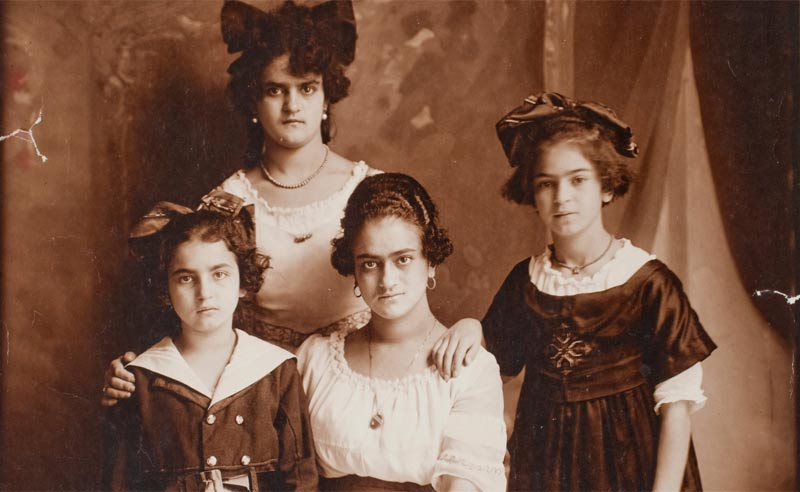
Frida Kahlo and her sisters -- www.aruma.com.au 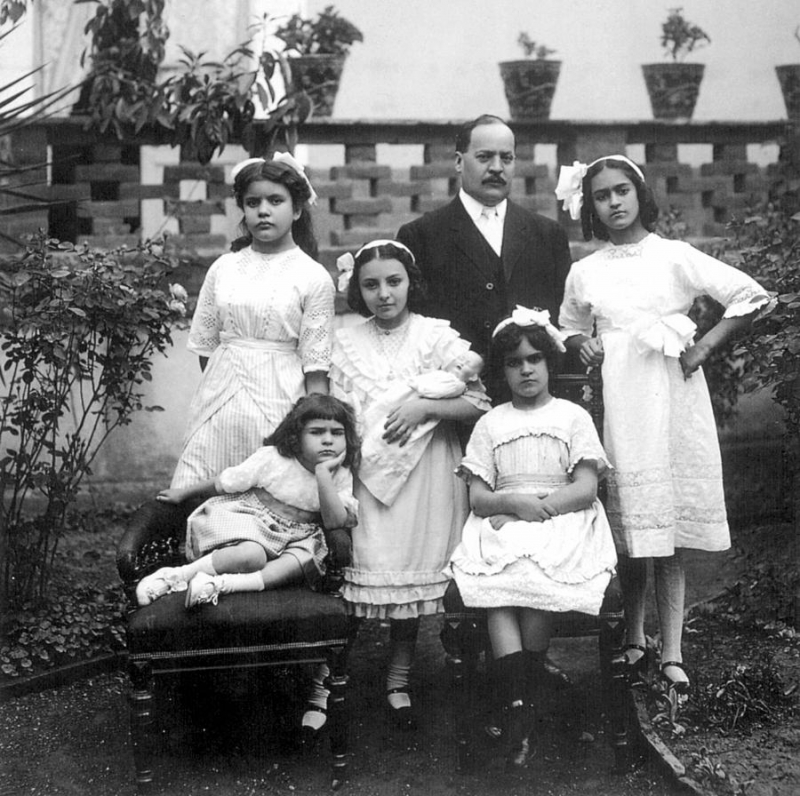
Frida Kahlo and her family -- www.aruma.com.au -
One of the interesting facts about Frida Kahlo is she almost became a doctor. Frida Kahlo wasn't always interested in becoming an artist. She undoubtedly inherited her father's appreciation for beautiful art from a young age. She also had some sketching instruction from an engraving buddy of her father's. She also assists her father professionally by editing, developing, and coloring pictures. However, she views art more as a pastime.
Kahlo was admitted to the prestigious National Preparatory School in 1922 and concentrated on the natural sciences to become a doctor. With only 35 girls out of 2,000 students, the university had just lately started accepting women. She was a strong student and an avid reader, and she developed a "deeply ingrained and serious commitment to Mexican culture, political action, and concerns of social justice". Out of 2,000 applicants, she was one of the first 35 girls (16 years old) accepted into the Escuela Nacional Preparatoria. At the time, it was Mexico's top school time.
The school preached Indigenismo, a new concept of Mexican identity that was proud of its indigenous past and aimed to shake off the colonial idea that Mexico was inferior to Europe. Nine of Kahlo's schoolmates, with whom she established an informal group nicknamed the "Cachuchas," had a significant impact on her at this time. They performed pranks, put on plays, discussed philosophy, and argued Russian classics because they were disobedient and rejected the traditional ideals of Mexico's patriarchal and macho society. Many of them rose to prominence within Mexico's intellectual elite.
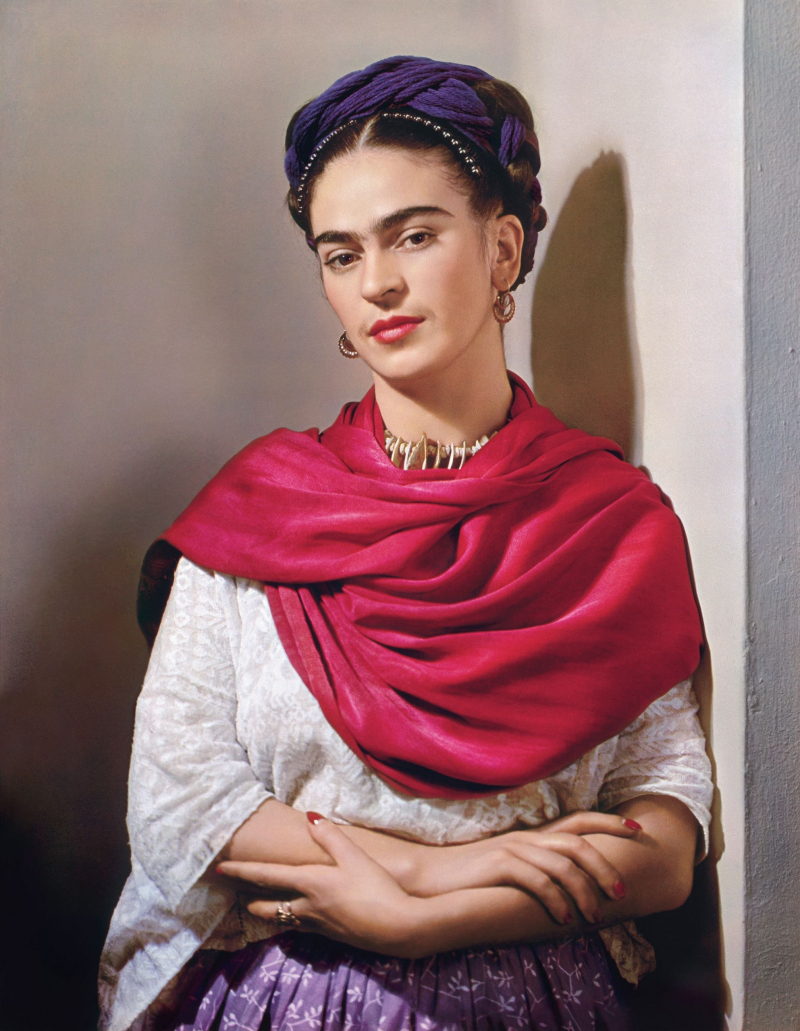
www.biography.com 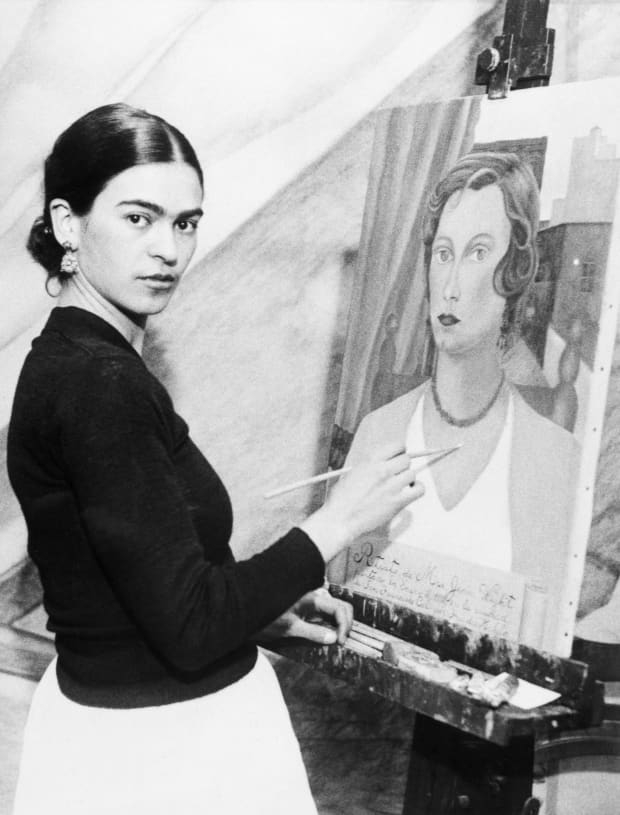
www.biography.com -
Ironically, Frida Kahlo was incapacitated for three months following a bus accident that made her give up her dream of becoming a doctor. Her bus collided with a tramway on September 17, 1925, while she was returning from school. Her fate was decided by this mishap. Even though she lived, she was gravely hurt. A metal rod had perforated her pelvic cavity, which would result in repeated miscarriages. Her right leg also sustains 11 fractures. Her shoulder is dislocated, and her right foot is entirely dislocated. Her femoral neck and spine are both fractured. She spends several months in bed, suffering severely. She would have 32 operations and wear 28 corsets in all during her life.
She feels compelled to remain in bed at home. I am not dead and I have a cause to live, she wrote at the time. Painting is the cause. Her family pushed her to paint because her medical studies were hampered. While her mother ordered a customized easel so that Kahlo could paint in her hospital bed, and had a mirror installed in the canopy, enabling Kahlo's self-portraiture, her father, an artist, loaned her his oil brushes. She found relief from all of her problems and a catalyst for recovery through art. She starts a significant collection of self-portraits. They will always be her favorite topic. Frida painted when she was at home, which helped launch her into a successful career as one of the most well-known and adored artists of all.
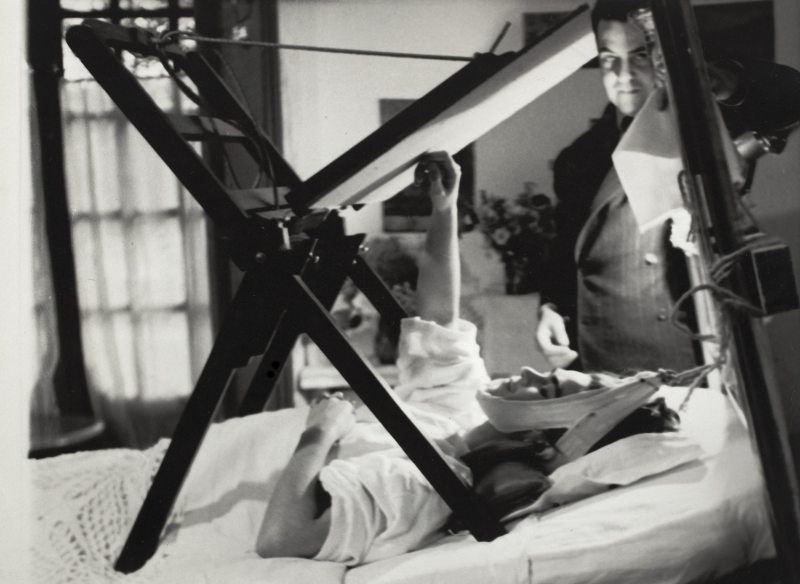
Frida Kahlo with her Special easel -- www.artgallery.nsw.gov.au 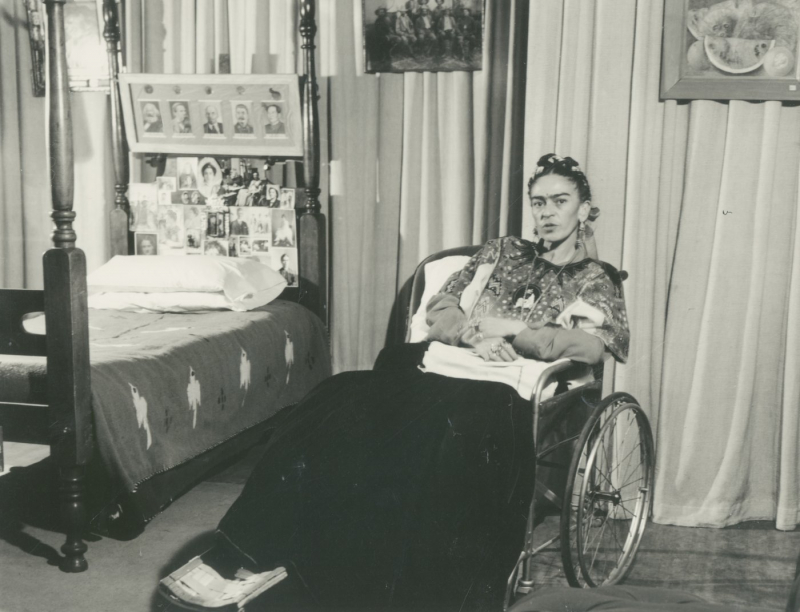
Frida is in a wheelchair -- www.artgallery.nsw.gov.au -
Not only as a teenager, Frida Kahlo developed a strong devotion to fighting for social justice and advancing Mexican culture but also within the Communist Party, in addition to class struggle, she was particularly committed to the emancipation and equality of women. As her health progressively became better in 1928, Frida Kahlo enrolled in the Mexican Communist Party, which is one of the interesting about Frida Kahlo. She decided to contribute since the political climate in her nation was unstable at the time. She granted political sanctuary to Leon Trotsky and his wife, a revolutionary communist, in 1937. Although her health is not good at that time. She has nevertheless been involved in the political movement despite her health challenges. She attended the July 2 protest against the US-backed ouster of Guatemalan President Jacobo Arbenz. This is her last public appearance.
She had a definite goal in mind: to help the situation of Mexican women. She campaigned for their freedom. She aimed to represent downtrodden women in a patriarchal culture. She rapidly adopted the persona of a "modern woman" and stopped feeling self-conscious about being bisexual. Frida Kahlo publicly promoted her anti-American attitude in her 1932 painting Self Portrait on the Border between Mexico and the United States, which she used to express her political sentiments. Feminists have praised Kahlo's work for what they see to be its uncompromising portrayal of the feminine experience and form, as well as for serving as an international symbol of Mexican national and indigenous traditions.
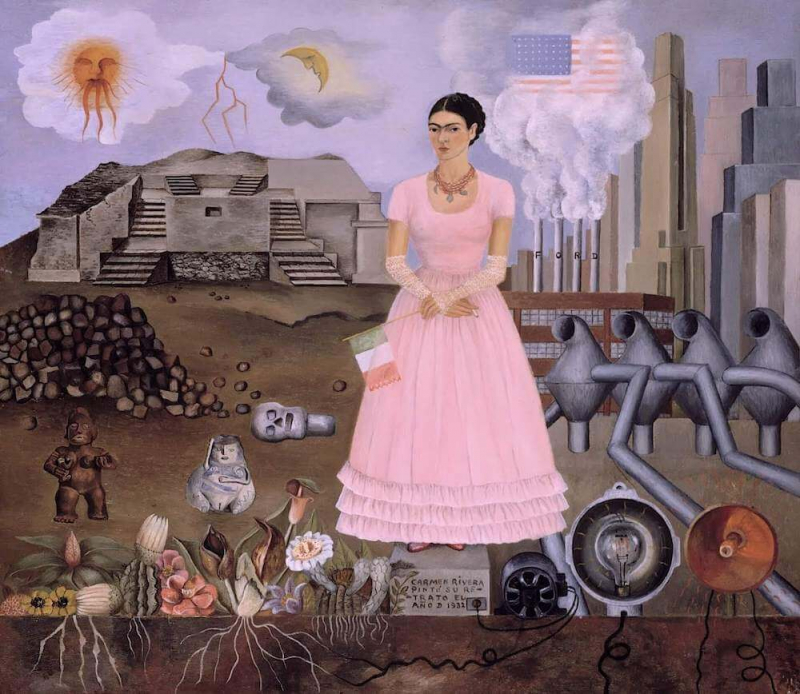
'Self-Portrait on the Border' -- www.fridakahlo.org 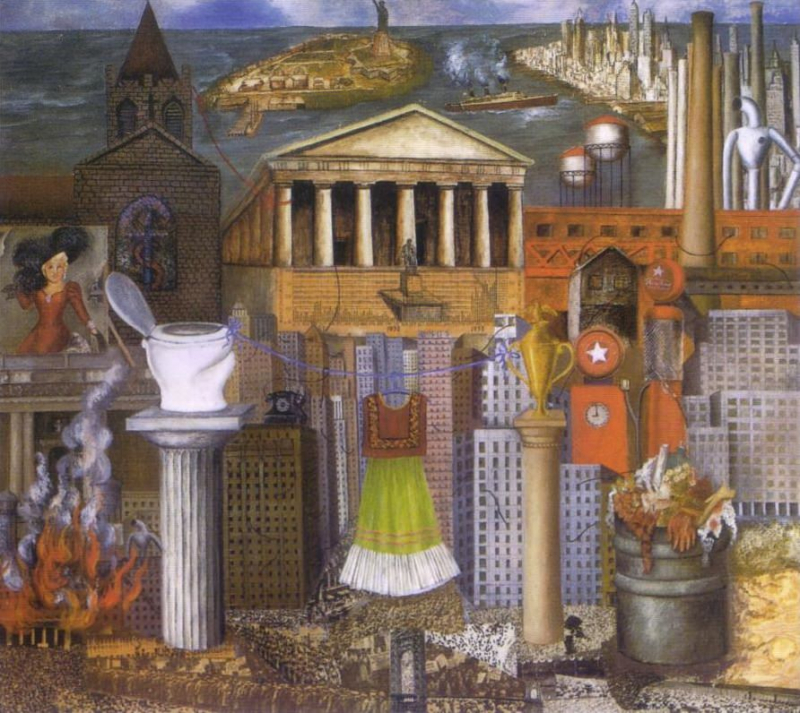
'My Dress Hangs There' -- www.fridakahlo.org -
Her crucial encounter with the muralist Diego Rivera also made 1928 stand out. He belongs to the Communist Party and is 20 years older than she. He was already well-known when he used his art to benefit the populace by producing substantial frescoes that the government had requested. They form a unique artistic pair thanks to their shared love of painting and politics as well as their mutual appreciation.
They got married in 1929, and their marriage was passionate and destructive. "I've had two really bad incidents in my life," she said. A bus caused one and Diego caused the other. The worst was by far Diego. Yes, she cheated on Diego multiple times, and he reciprocated. She considered her husband's connection with her sister in 1935 to be an actual betrayal. They spend several months apart from the marital home, yet their love is unwavering. By having an affair with the communist revolutionary Leon Trotsky, Frida also jeopardizes her marriage. The Russian politician had been housed in their home in 1937 after being given political refuge in Mexico. They were divorced in 1938, got remarried in 1940, and remained together until their deaths.
Their first marriage's residence is symbolic of how they feel about one another. They are made up of two separate structures that are connected by a bridge: white and pink for Diego, and blue for Frida. It serves as a symbol of their relationship—independent yet inextricably linked.
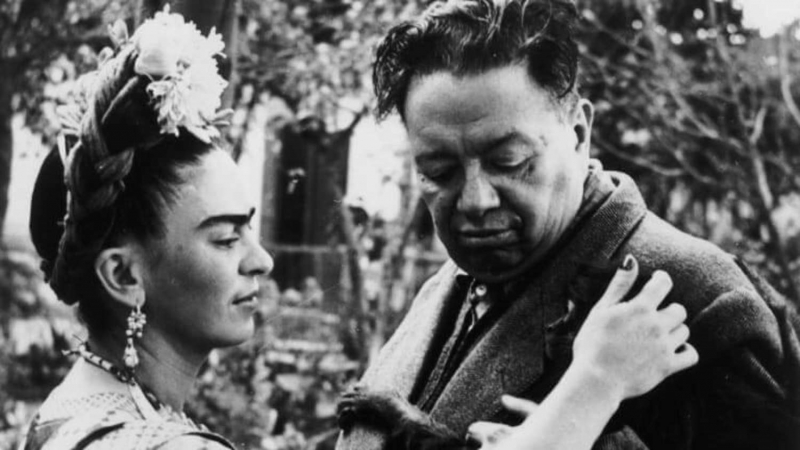
Frida Kahlo and her husband -- vi.wikipedia.org 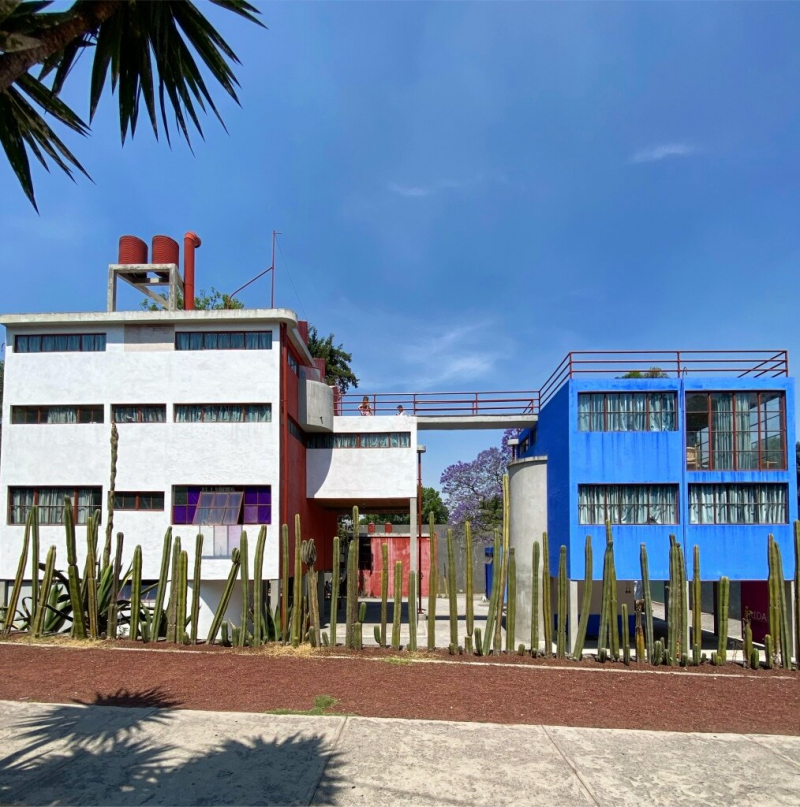
Museo Casa Estudio Diego Rivera y Frida Kahlo -- rachelneilson.com -
The surrealist André Breton encountered Frida Kahlo's artwork when visiting Mexico City in 1938, making Frida Kahlo a friend. He invited her to Paris in 1939 to participate in a significant show in Mexico because he was fascinated by her. She was unhappy with the city and the show, though. She called the occasion a "smokehouse." It was way too picturesque and caricatured of her country. Additionally, some of her drawings were lost, while others were misconstrued. "Until André Breton arrived in Mexico and informed me I was one," remarked Frida, "I never thought of myself as a Surrealist."
Surrealism has been used to describe Frida Kahlo's artwork. Unrealistic features are present, with Kahlo appearing as a human head on a deer's body or sprouting roots being prime instances. Some claim that her art is classified as surrealism. The idea that Frida Kahlo's art was surrealistic was rejected by the artist herself. She said: "It's not fair, she thinks. Never did I paint a dream. What I depicted was my reality". She considers her paintings to be mostly autobiographical.
However, her trip to France marks the start of her receiving recognition on a global scale. Admired in the Parisian art scene, Picasso gave her hand-shaped ivory earrings, Schiaparelli created the Madame Rivera outfit for her, and the Louvre purchased a self-portrait for her. A great and acclaimed artist like Frida Kahlo undoubtedly has a few historical firsts to her credit. When the Louvre Museum acquired her painting, The Frame, in 1939, Kahlo became the first Mexican artist of the 20th century to have their work displayed there—or in any other significant, well-known gallery, for that matter. Another claim to fame is that Frida Kahlo was the first woman to sell a piece of art to the Louvre.
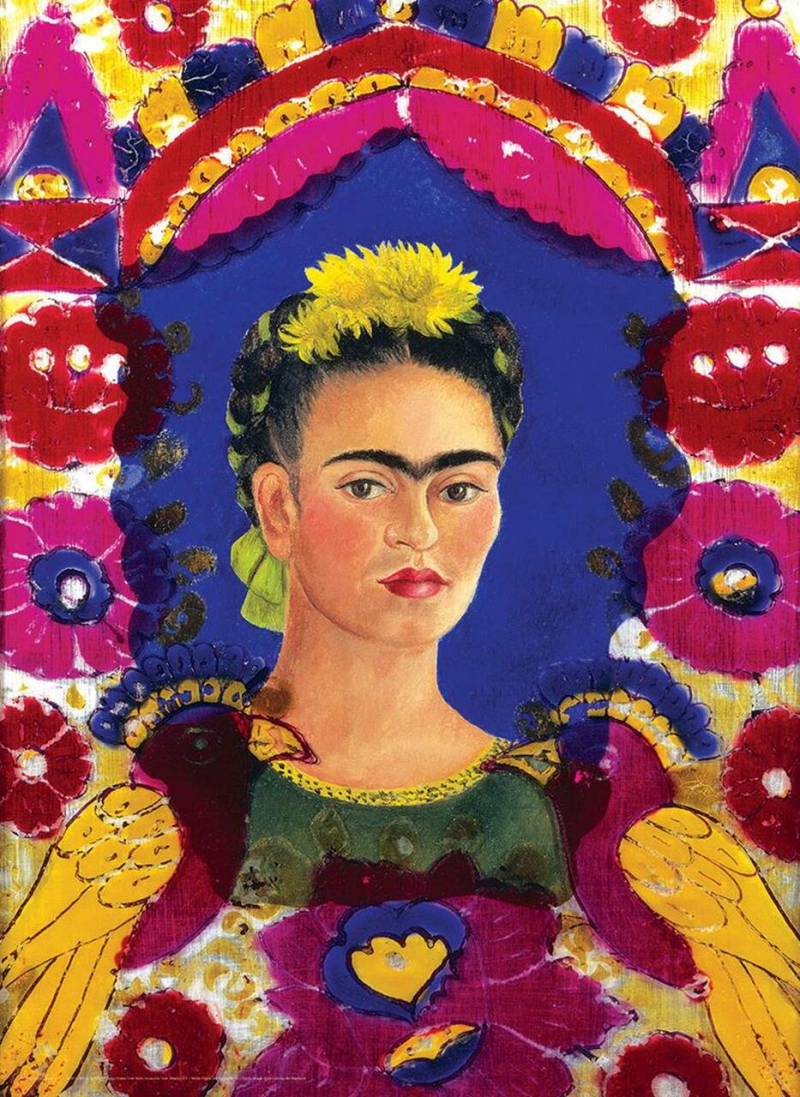
'The Frame' -- www.fridakahlo.org 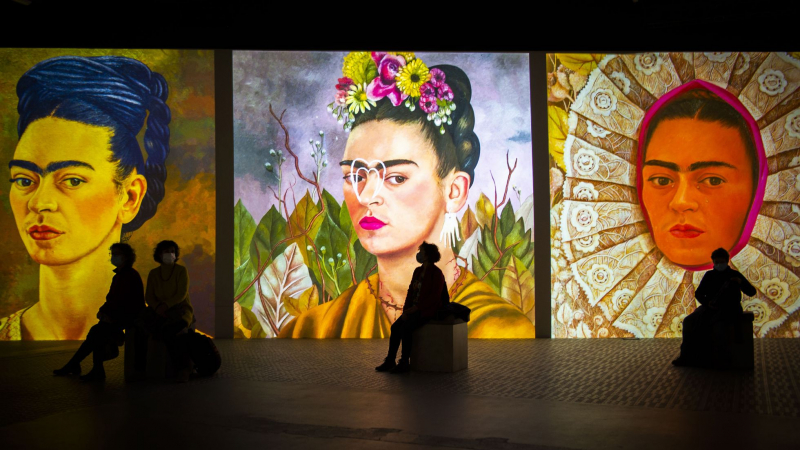
www.artgallery.nsw.gov.au -
Frida Kahlo's artwork was intensely personal and represented the sadness in her life, as we briefly mentioned previously. She poured her heart and energy into her work, providing us with a glimpse into her life in the process. She discussed her troubled marriage to Diego Rivera, her inability to have children, her bus accident, her deteriorating health, and her general outlook on life. Around 60 self-portraits were among the 150 paintings Frida produced throughout her lifetime. "I paint myself because I am alone so much of the time and because I am the subject I know best," remarked Kahlo. In My Nurse and I (1937), she gives a retrospective account of her childhood and occasionally includes her parents. As in the artwork Henry Ford Hospital, she also depicts her relationship and talks about their miscarriages (1932).
Her life and work are interwoven. Her works are metaphorical biography of her life. The Broken Column, one of Frida Kahlo's most well-known images, was created in the year 1944. She portrayed herself as divided down the middle and nude in this picture. Her back is broken like a column. She has nails all over her body and is wearing a medical brace, which are signs of the constant suffering she endured. Frida used her art to convey her physical difficulties in this artwork. She underwent a few operations at that time, and to preserve her back spine, she had to wear specialized corsets. She receives a lot of medical care for her chronic pain, but nothing has been truly effective.
Additionally, Kahlo included political statements and feelings in several of her works. She emphasizes more of her "Mexicanness" in her self-portraits. It demonstrates her ardent love for the rich cultural history of her country. In actuality, she frequently dons the beautiful, floral-embroidered China Poblano, a traditional garment. She also regularly sports flower-adorned braids or buns. More generally, Mexican culture is shown in many of her works, particularly through its flora and wildlife. She incorporates local folklore (flags, gorgeous corpses, and parrots and cactus) as well as other objects into her works. Several of her artworks also prominently display her passion for politics. Marxism will restore Health to the Sick (1954) and Her Self-Portrait with Stalin (1954) attest to this. Numerous allusions to death may be seen near the end of her life when she portrays herself as a deer that has been shot with arrows or standing next to corpses.
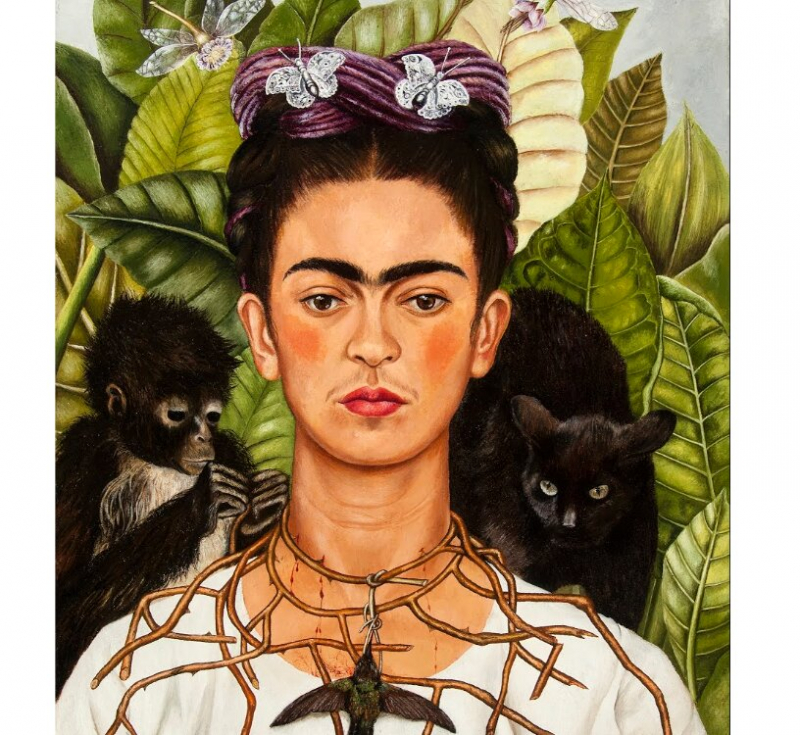
'Self-Portrait with Thorn Necklace and Hummingbird' -- www.fridakahlo.org 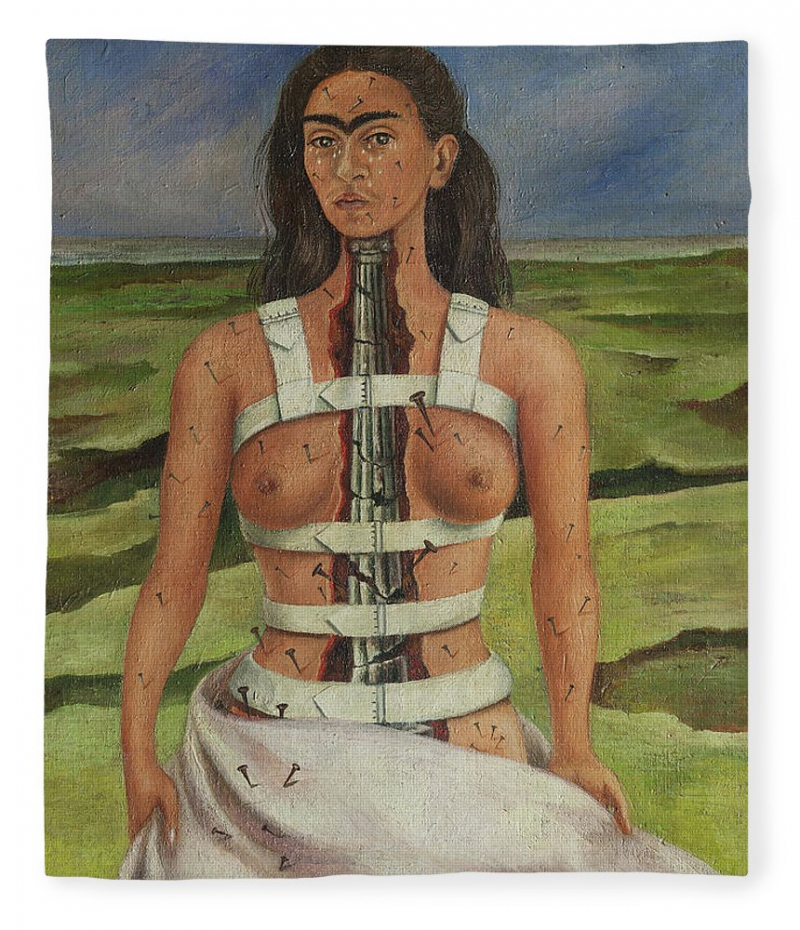
'The Broken Column' -- www.fridakahlo.org -
Frida's health deteriorated shortly after her gallery's debut, and finally, gangrene forced her to amputate her right leg below the knee. Her dependence on medicines grew as she developed depression and anxiety. Kahlo spent the majority of her final days in bed due to bronchopneumonia. She nevertheless addressed and attended a protest against the CIA invasion of Guatemala. Later, her condition got worse, and that night she was in excruciating agony and had a high temperature.
Frida passed away at age 47 on the night in 1954 at her beloved Bule House, it's also where she was born. She was publicly reported to die of a pulmonary embolism, however, some speculate that she could have overdosed or committed suicide instead. A face-shaped urn containing her cremated remains is placed next to her bed. "I hope the leaving is happy — and I hope never to return," she wrote in her journal a few days before she passed away.
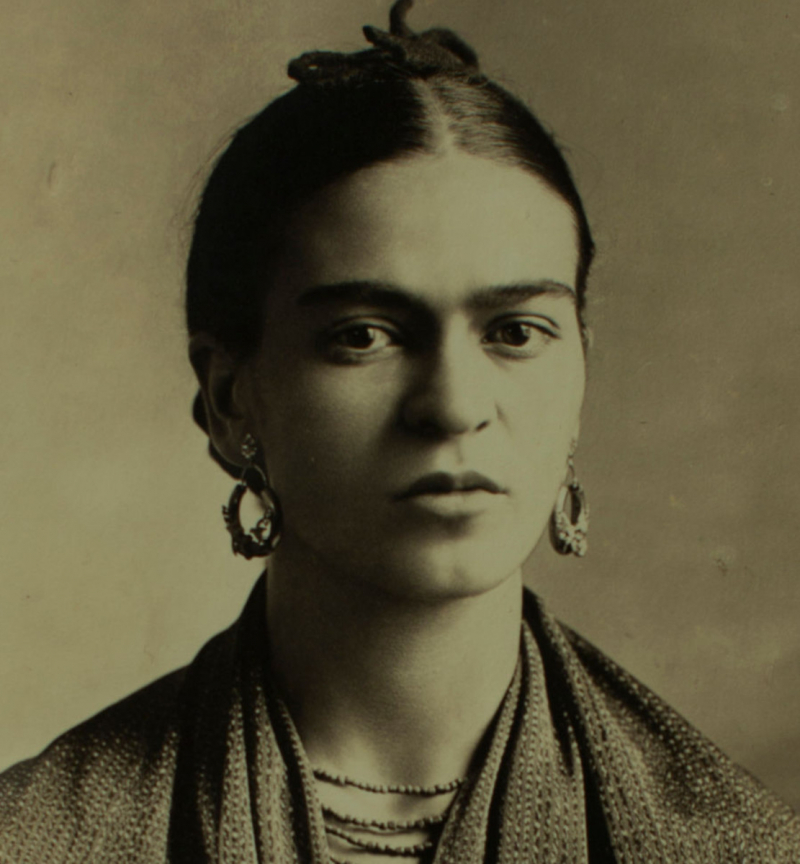
www.history.com 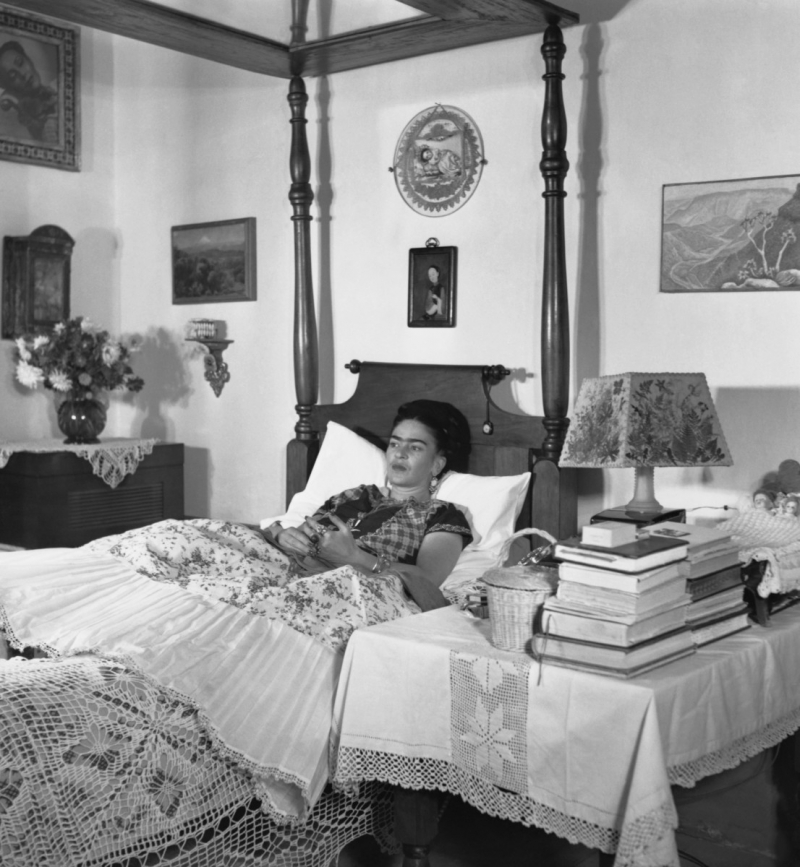
www.history.com -
She spent a long time living in her husband's shadow, but her nomination to the Seminario de Cultura Mexicana in 1942 attests to the fact that she was acknowledged by governmental organizations. The government established the Seminario de Cultura Mexicana, a collection of well-known figures from the cultural world, to promote Mexican culture through publications, seminars, and exhibitions. Besides, her Blue House was opened as a museum in the year of 1958.
The Mexican Federal Bank decided to adorn one side of a new 500 peso note in 2010 with her image and the other with Diego Rivera's. Frida Kahlo was the first Hispanic woman to be featured on a US postage stamp, which was another historic first. Her 1933 self-portrait with the necklace was featured on the stamp, which was published on June 21, 2001. On the same day, the Frida stamp was also released by the Mexican Postal Service. In addition to being a landmark in the history of art, the Chicano movement, which fought for the civil rights of Mexican-Americans, adopted it as policy in the 1990s.
Her art also didn't receive widespread praise until a few years after she passed away. In the 1970s, her renown expanded, and by the 21st century, it had reached what some reviewers dubbed "Fridamania." Her iconic painting, Two Nudes in a Forest, which sold for $8 million in 2016, is just one example of how her work's worth has increased over the years. Kahlo's life and work have been the subject of several articles, books, and films, including the best-selling Frida: The Biography of Frida Kahlo (1983) by Hayden Herrera. In 1983, the film "Frida, Naturaleza viva" was released and was a tremendous hit. Salma Hayek portrays Frida in the 2002 biographical picture "Frida," which also made over $50 million worldwide and won two Academy Awards.
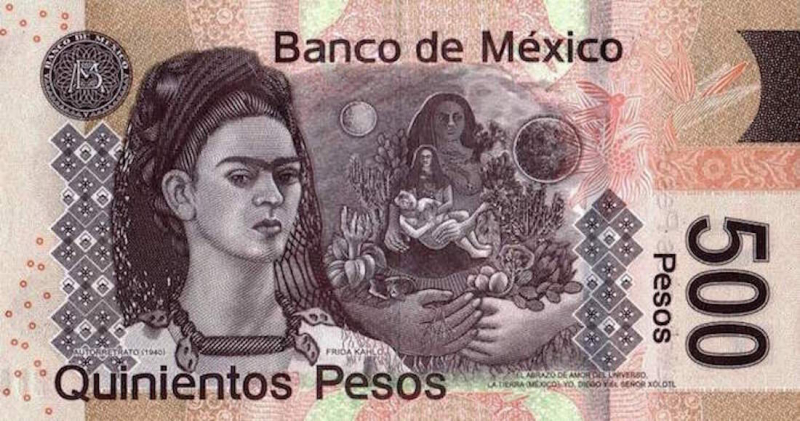
Frida on the Mexican 500 pesos notes -- www.shutterstock.com 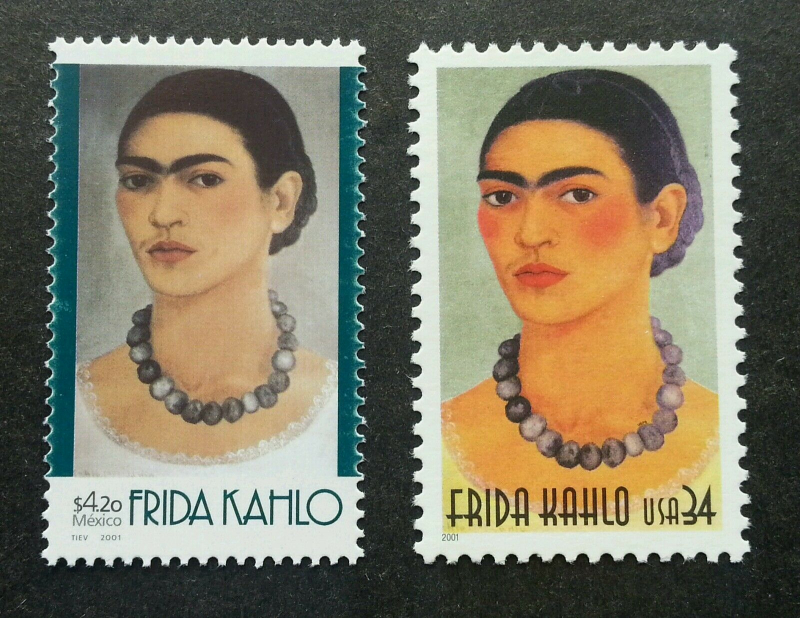
Frida Kahlo Postage Stamps -- www.amazon.com
































